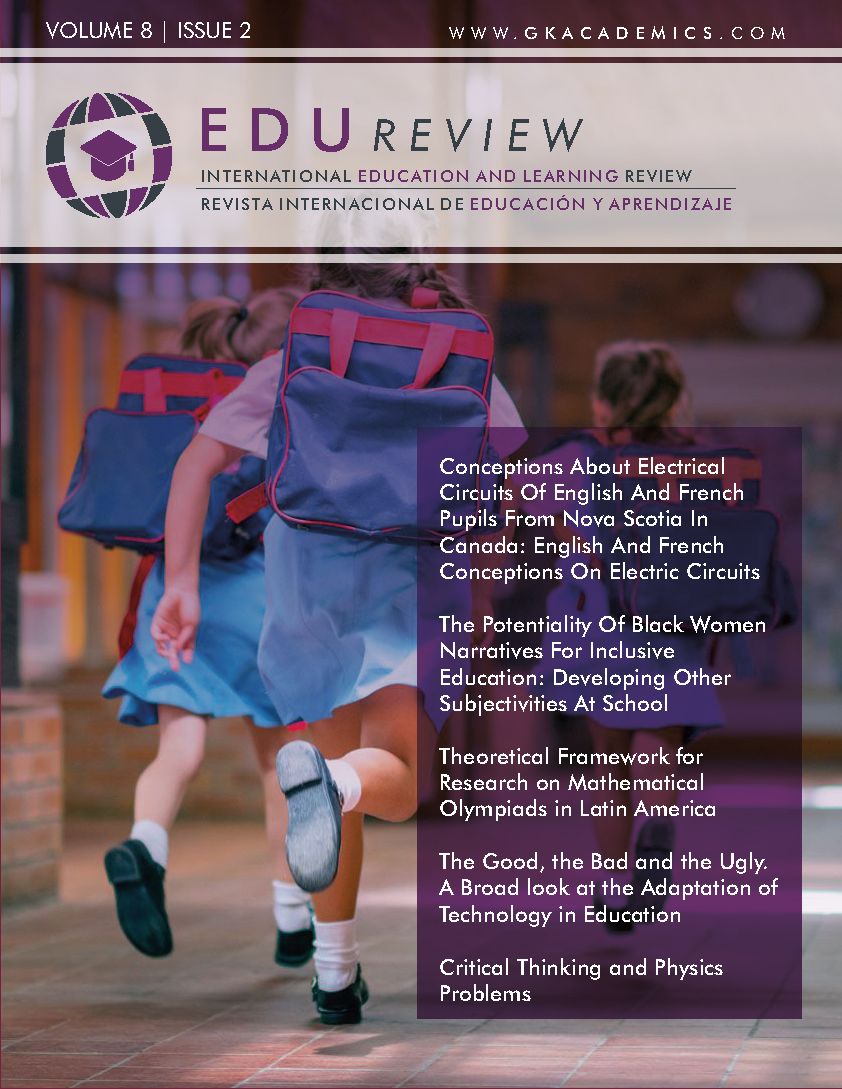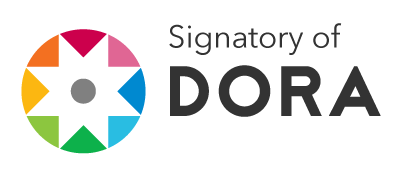The Good, the Bad and the Ugly . A Broad look at the Adaptation of Technology in Education
DOI:
https://doi.org/10.37467/gka-revedu.v8.2662Palabras clave:
Technology, Education, Technology in Education, User Experience, UI, UXResumen
Technology in education is a global phenomenon affecting learners of all ages. The breadth and variety of available tools make it difficult to implement a standardized method for assessing the impact of technology on learning. The lack of a consensus on good and bad practices results in inconsistent application and mixed learning results.
This article takes a look at the adaptation of technology to education and examines the various tools used to enhance learning. We discuss the advantages and disadvantages of using technology, as well as review methodologies for evaluating the impact.
The essay concludes by identifying several problems with the way technology is evaluated and offers suggestions for further research to address those problems.
Descargas
Estadísticas globales ℹ️
|
2500
Visualizaciones
|
929
Descargas
|
|
3429
Total
|
|
Citas
Adeyemo, S., Adedoja, G., & Adelore, O. (2013). Mobile technology: Implications of its application on learning. Open Praxis, 5(3), 249-254. DOI: https://doi.org/10.5944/openpraxis.5.3.68
Adkins, S. S. (2011). The worldwide market for mobile learning products and services: 2010–2015 forecast and analysis. Ambient Insight’s 2010–2015 Worldwide Market Forecast for Mobile Learning Products and Services, 5-21
Ambrose, R. M., & Palpanathan, S. (2017). Investigating the effectiveness of computer-assisted language learning (CALL) using Google Documents in enhancing writing-- a study on senior 1 students in a Chinese independent high school. IAFOR Journal of Language Learning, 3(2), 85-112. DOI: https://doi.org/10.22492/ijll.3.2.04
Bachore, M. M. (2015). Language learning through mobile technologies: An opportunity for language learners and teachers. Journal of Education and Practice, 6(31), 50-53.
Bluemel, B. (2014). Learning in parallel: Using Parallel Corpora to enhance written language acquisition at the beginning level. Dimension, 31, 48.
Bodnar, J. R., & Petrucelli, S. L. (2016). Strengthening academic writing. NADE digest, 9(1), 40-43.
Brasiel, S., Jeong, S., Ames, C., Lawanto, K., Yuan, M., & Martin, T. (2016). Effects of educational technology on mathematics achievement for K-12 students in Utah. Journal of Online Learning Research, 2(3), 205-226.
Braun, V., & Clarke, V. (2012). Thematic analysis. In H. Cooper, P.M. Camic, D. L. Long, A. T. Panter, D. Rindskopf, & K. J. Sher (Eds.), APA handbook of research methods in psychology, vol. 2: Research designs: Quantitative, qualitative, neuropsychological, and biological (pp. 57–71). Washington, DC: American Psychological Association.
Camposa, H., Teixeira, E., & Catarinoa, P. (2015). Mathematics and children's literature linked by e-Books. Turkish Online Journal of Educational Technology-TOJET, 14(4), 93-101.
Claesgens, J., Rubino-Hare, L., Bloom, N., Fredrickson, K., Henderson-Dahms, C., Menasco, J., & Sample, J. (2013). Professional development integrating technology: Does delivery format matter? Science Educator, 22(1), 10-18.
Coskun, H., Dogan, A., & Uluay, G. (2017). The effect of technology on students' opinions about authentic learning activities in science courses. Universal Journal of Educational Research, 5(1), 72-83. DOI: https://doi.org/10.13189/ujer.2017.050109
Evmenova, A. (2018). Preparing teachers to use universal design for learning to support diverse learners. Journal of Online Learning Research, 4(2), 147-171.
Gallagher, M. S., & Ihanainen, P. (2015). Aesthetic literacy: Observable phenomena and pedagogical applications for mobile lifelong learning (MLLL). European Journal of Open, Distance and E-learning, 18(1), 15-33. DOI: https://doi.org/10.1515/eurodl-2015-0002
Garcia, E., Brown, M., & Elbeltagi, I. (2013). Learning within a connectivist educational collective blog model: A case study of UK higher education. The Electronic Journal of E-Learning, 11(3), 253-262.
Gimeno-Sanz, A., Dónaill, C. Ó., & Andersen, K. (2014, December). Supporting content and language integrated learning through technology. In CALL Design: Principles and Practice-Proceedings of the 2014 EUROCALL Conference, Groningen, The Netherlands (pp. 107-112). Research-publishing. net. DOI: https://doi.org/10.14705/rpnet.2014.000203
Grant, N. S., & Bolin, B. L. (2016). Digital storytelling: A method for engaging students and increasing cultural competency. Digital Storytelling, 16(3), 44-61.
Henderson, M., Selwyn, N., Finger, G., & Aston, R. (2015). Students’ everyday engagement with digital technology in university: exploring patterns of use and ‘usefulness’. Journal of Higher Education Policy and Management, 37(3), 308-319. DOI: https://doi.org/10.1080/1360080X.2015.1034424
Hewitt, A., & Stubbs, M. (2017). Supporting law students’ skills development online – a strategy to improve skills and reduce student stress? Research in Learning Technology, 25. DOI: https://doi.org/10.25304/rlt.v25.1786
Izadpanah, S., & Alavi, M. (2016). The perception of EFL high school students in using of computer technology in the process of learning: merits and demerits. Advances in Language and Literary Studies, 7(3), 146-156. DOI: https://doi.org/10.7575/aiac.alls.v.7n.3p.146
Joan, R. (2013). Flexible learning as new learning design in classroom process to promote quality education. I-Manager’s Journal on School Educational Technology, 9(1), 37–42. DOI: https://doi.org/10.26634/jsch.9.1.2401
Scalise, K. (2016). Student collaboration and school educational technology: Technology integration practices in the classroom. I-Manager’s Journal on School Educational Technology, 11(4), 53-63
Kates, F., Byrd, M., & Haider, H. (2015). Every picture tells a story: The power of 3 teaching method. Journal of Educators Online, 12(1), 189-211. DOI: https://doi.org/10.9743/JEO.2015.1.1
Keegan, D., Kismihok, G., Krämer, B., Simpson, B., & Vertecchi, B. (2008). The Impact of new technologies on distance learning students. Research Report 3/2008 FernUniversitat in Hagen, 49.
Khan, A. A., & Khader, S. A. (2014). An approach for externalization of expert tacit knowledge using a query management system in an e-learning environment. International Review of Research in Open and Distributed Learning, 15(6), 257-274. DOI: https://doi.org/10.19173/irrodl.v15i6.1935
Lai, A., & Savage, P. (2013). Learning management systems and principles of good teaching: Instructor and student perspectives. Canadian Journal of Learning and Technology/La revue canadienne de l’apprentissage et de la technologie, 39(3). DOI: https://doi.org/10.21432/T24S39
Latif, F. (2017). TELFest: an approach to encouraging the adoption of educational technologies. Research in Learning Technology, 25. DOI: https://doi.org/10.25304/rlt.v25.1869
Lawrie, G. A., Gahan, L. R., Matthews, K. E., Weaver, G. C., Bailey, C., Adams, P., ... & Taylor, M. (2014). Assessment of small group collaborative. Science Education, 7(2), 120-135. DOI: https://doi.org/10.5204/jld.v7i2.204
Liu, N. (2013). iPad infuse creativity in solid geometry teaching. Turkish Online Journal of Educational Technology-TOJET, 12(2), 177-192.
Lumpkin, A., Achen, R. M., & Dodd, R. K. (2015). Using technology-nested instructional strategies to enhance student learning. InSight: A Journal of Scholarly Teaching, 10, 12. 114-125. DOI: https://doi.org/10.46504/10201509lu
Magdin, M., & Turčáni, M. (2015). Personalization of student in course management systems on the basis using method data mining. The Turkish Online Journal of Educational Technology, 14(1), 58-67.
Mtebe, J., & Raisamo, R. (2014). Investigating students’ behavioural intention to adopt and use mobile learning in higher education in East Africa. International Journal of Education and Development using ICT, 10(3).
Mukama, E. (2014). Bringing technology to students’ proximity: a sociocultural account of technology-based learning projects. International journal for research in vocational education and training, 1(2), 125-142. DOI: https://doi.org/10.13152/IJRVET.1.2.3
Njagi, K., Mugo, D. G., Chemwei, B., & Gakuru, P. M. (2015). Supporting university learning through mobile technologies: A global perspective. International Journal of Education and Literacy Studies, 3(3), 42-48. DOI: https://doi.org/10.7575/aiac.ijels.v.3n.3p.42
O’Brien, E., & Hamburg, I. (2013). Organisational problem based learning and social communities for SMEs. European Journal of Open, Distance and E-learning, 16(2).
Ouyang, J. R., & Stanley, N. (2014). Theories and research in educational technology and distance learning instruction through Blackboard. Universal Journal of Educational Research, 2(2), 161-172. DOI: https://doi.org/10.13189/ujer.2014.020208
Podeschi, R. (2016). Building I.S. professionals through a real-world client project in a database application development course. Information Systems Education Journal, 14(6), 34.
Puentedura, R. R. (2015). SAMR: A brief introduction. unpublished. Retrieved from http://www. hippasus. com/rrpweblog/archives/2013/10/02/SAMR_ABriefIntroduction. pdf.
Rolfe, V. (2015). A systematic review of the socio-ethical aspects of Massive Online Open Courses. European Journal of Open, Distance and E-learning, 18(1), 52-71. DOI: https://doi.org/10.1515/eurodl-2015-0004
Scalise K. (2016). Student collaboration and school educational technology: Technology integration practices in the classroom. I-Manager’s Journal on School Educational Technology, 11(4), 53-63. DOI: https://doi.org/10.26634/jsch.11.4.6012
Siraj, S. (2014). Interpretive structural modeling of mLearning curriculum implementation model of English language communication skills for undergraduates. The Turkish Online Journal of Educational Technology, 13(1), 151-161.
Snape, P. (2017). Enduring Learning: Integrating C21st Soft Skills through Technology Education. Design and Technology Education, 22(3), n3.
Sun, J., & Flores, J. (2013). Student characteristics and e-textbook experiences: The direct and moderating effects of technology savvy and gender. Information Systems Education Journal, 11(3), 4.
Sun, J., & Wang, Y. (2014). Tool choice for e-learning: Task-technology fit through media synchronicity. Information Systems Education Journal, 12(4), 17.
Thompson, C. M., Anttila, E., Ruthmann, S. A., & Doan, W. J. (2013). Where I’m from: Cultural exchange through the arts and voice thread. International Journal of Education & the Arts, 14 (13), 12.
Thota, N., & Negreiros, J. G. (2015). Introducing educational technologies to teachers: Experience report. Journal of University Teaching & Learning Practice, 12(1), 5. DOI: https://doi.org/10.53761/1.12.1.5
Descargas
Publicado
Cómo citar
Número
Sección
Licencia
Los autores/as que publiquen en esta revista aceptan las siguientes condiciones:
- Los autores/as conservan los derechos de autor.
- Los autores/as ceden a la revista el derecho de la primera publicación. La revista también posee los derechos de edición.
- Todos los contenidos publicados se regulan mediante una Licencia Atribución/Reconocimiento-SinDerivados 4.0 Internacional. Acceda a la versión informativa y texto legal de la licencia. En virtud de ello, se permite a terceros utilizar lo publicado siempre que mencionen la autoría del trabajo y a la primera publicación en esta revista. Si transforma el material, no podrá distribuir el trabajo modificado.
- Los autores/as pueden realizar otros acuerdos contractuales independientes y adicionales para la distribución no exclusiva de la versión del artículo publicado en esta revista (p. ej., incluirlo en un repositorio institucional o publicarlo en un libro) siempre que indiquen claramente que el trabajo se publicó por primera vez en esta revista.
- Se permite y recomienda a los autores/as a publicar su trabajo en Internet (por ejemplo en páginas institucionales o personales), una vez publicado en la revista y citando a la misma ya que puede conducir a intercambios productivos y a una mayor y más rápida difusión del trabajo publicado (vea The Effect of Open Access).













